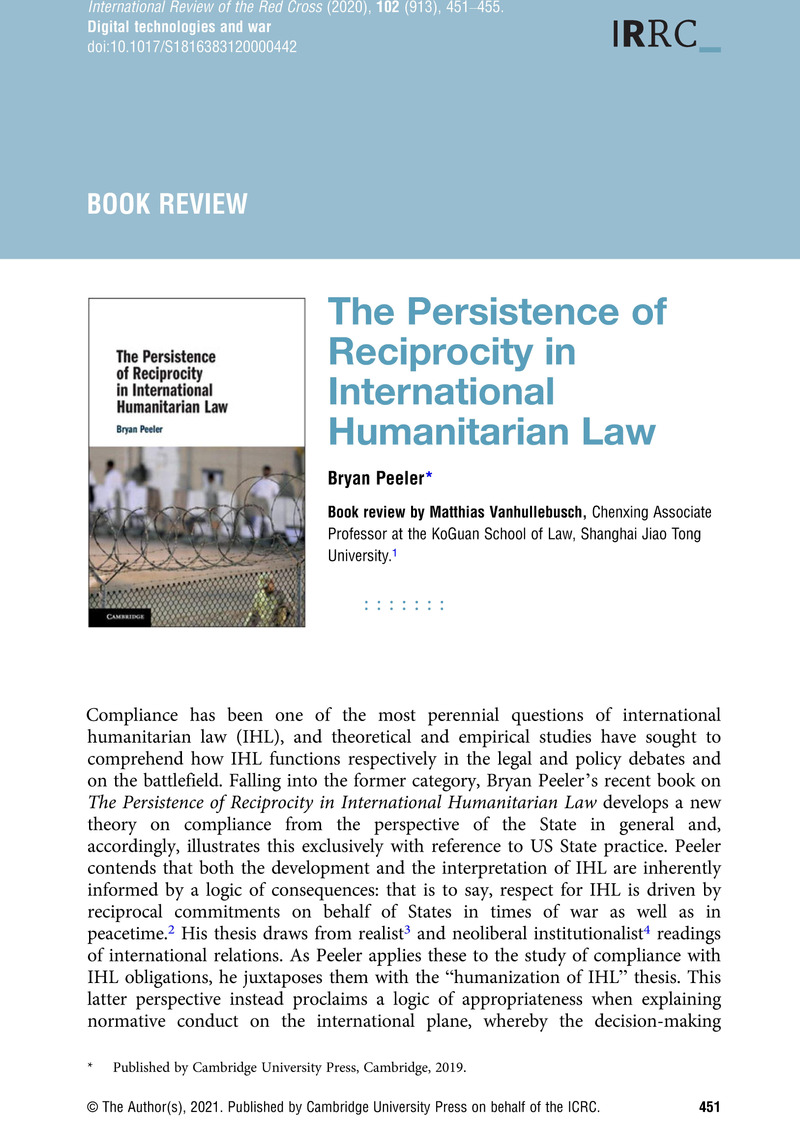No CrossRef data available.
Article contents
The Persistence of Reciprocity in International Humanitarian Law Bryan Peeler *
Published online by Cambridge University Press: 21 January 2021
Abstract

- Type
- Books and articles
- Information
- International Review of the Red Cross , Volume 102 , Issue 913: Digital technologies and war , April 2020 , pp. 451 - 455
- Copyright
- Copyright © The Author(s), 2021. Published by Cambridge University Press on behalf of the ICRC.
Footnotes
Published by Cambridge University Press, Cambridge, 2019.
Dr Matthias Vanhullebusch (PhD, SOAS) is a Visiting Professor on various training programmes organized by the International Committee of the Red Cross (ICRC) across Asia. He has been a Visiting Scholar at the Geneva Academy of International Humanitarian Law and Human Rights, the Oxford Institute for Ethics, Law and Armed Conflict, and the Asia-Pacific Centre for Military Law.
References
2 The Persistence of Reciprocity in International Humanitarian Law, pp. 39, 42.
3 According to Peeler, realist theories “deny that IHL can have … an independent constraining effect on the behaviour of states”. Ibid., p. 23.
4 In order to ensure compliance with IHL obligations, Peeler argues, “neoliberal institutionalism suggests that states include measures implementing the strategy of TFT [tit-for-tat] into the law”. Ibid., p. 23.
5 Ibid., p. 40.
6 Peeler considers that liberal international relations theories responsibilize the agent to promote “a culture of IHL compliance”. Ibid., p. 46.
7 Constructivists, from the perspective of Peeler, believe that compliance with international norms is possible given States’ capacity towards socialization – or internalization – of international law. Ibid., p. 48.
8 According to Keohane, specific reciprocity occurs when “specified partners exchange items of equivalent value in a strictly delimitated sequence. If any obligations exist, they are clearly specified in terms of rights and duties of particular actors.” See Keohane, Robert, “Reciprocity in International Relations”, International Organization, Vol. 40, No. 1, 1989, p. 4Google Scholar.
9 What distinguishes specific from diffuse reciprocity is, according to Keohane, the involvement of multiple actors concerned with the behaviour of other actors with whom they do not entertain a specific relationship, which affects in turn how they will perform certain obligations under international law vis-à-vis each other in different situations and across different timeframes. Here, according to Keohane, “the definition of equivalence is less precise, one's partners may be viewed as a group rather than as particular actors, and the sequence of events is less narrowly bounded. Obligations are important.” Ibid., p. 4.
10 The Persistence of Reciprocity in International Humanitarian Law, pp. 12–58.
11 Ibid., pp. 59–94.
12 Ibid., p. 93.
13 Ibid., pp. 95–127.
14 Ibid., pp. 128–168.
15 Peeler refers to Hart's distinction of primary and secondary rules, explaining that “the primary rules of a legal system are those rules that either forbid or require certain actions and generate duties or obligations. The secondary rules, on the other hand, are rules that describe the manner in which we recognize, change and adjudicate violations of primary rules.” Ibid., p. 42. See also Hart, Herbert L. A., The Concept of Law, Oxford University Press, Oxford, 1961, p. 87Google Scholar.
16 The Persistence of Reciprocity in International Humanitarian Law, pp. 145–146.
17 Mark Osiel, The End of Reciprocity, Cambridge University Press, Cambridge, 2009, p. 73.
18 The Persistence of Reciprocity in International Humanitarian Law, pp. 95, 103, 113.
19 Ibid., pp. 115, 117.
20 Ibid., pp. 124, 134.
21 Military Commission Act, Pub. L. 109-366, 120 Stat. 2600, 17 October 2006; Military Commission Act, Pub. L. 111-84, 123 Stat. 2574, 28 October 2009.
22 The Persistence of Reciprocity in International Humanitarian Law, pp. 130, 141.
23 Ibid., p. 132.
24 Supreme Court of the United States, Hamdan v. Rumsfeld, 548 US 557 (2006), 2006.
25 Supreme Court of the United States, Boumediene v. Bush, 128 US 2229 (2008), 2008.
26 The Persistence of Reciprocity in International Humanitarian Law, p. 153.
27 Ibid., p. 152. Needless to say, once the conditions for its applicability have been satisfied, IHL governs the conduct of all fighting parties irrespective of their causes of warfare.
28 Ibid., pp. 110–112.
29 Daniel Muñoz-Rojas and Jean-Jacques Frésard, The Roots of Behaviour in War: Understanding and Preventing IHL Violations, ICRC, Geneva, 2004. This study identifies the principal cause of violations of IHL as the moral disengagement of the fighters in the course of armed conflicts. In other words, parties to the conflict justify their violations of IHL by having recourse to their superior moral and/or religious cause of warfare and by dehumanizing their opponents – both fighters and civilian populations.
30 In his concluding chapter, Peeler briefly touches on the challenges presented by the Trump administration regarding its (lack of) respect for international norms, including IHL. See The Persistence of Reciprocity in International Humanitarian Law, pp. 176–184.




